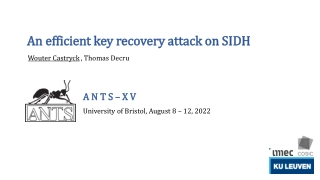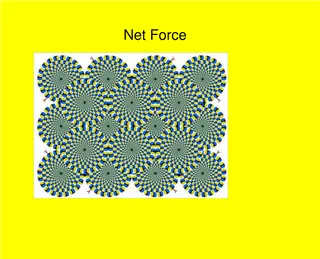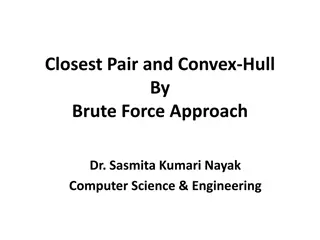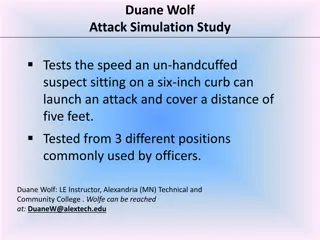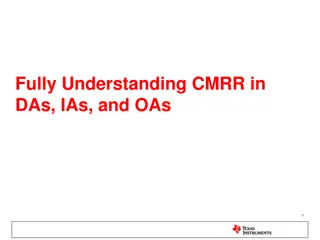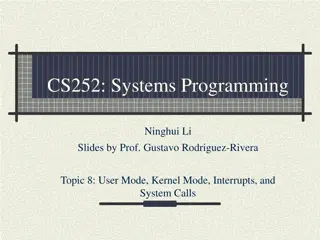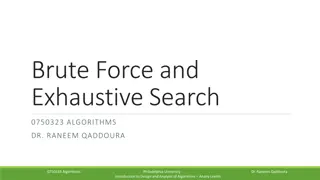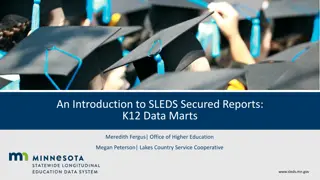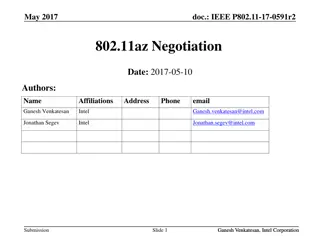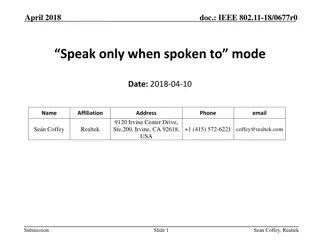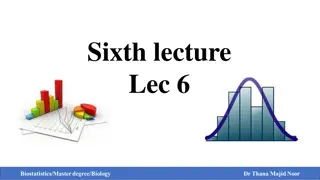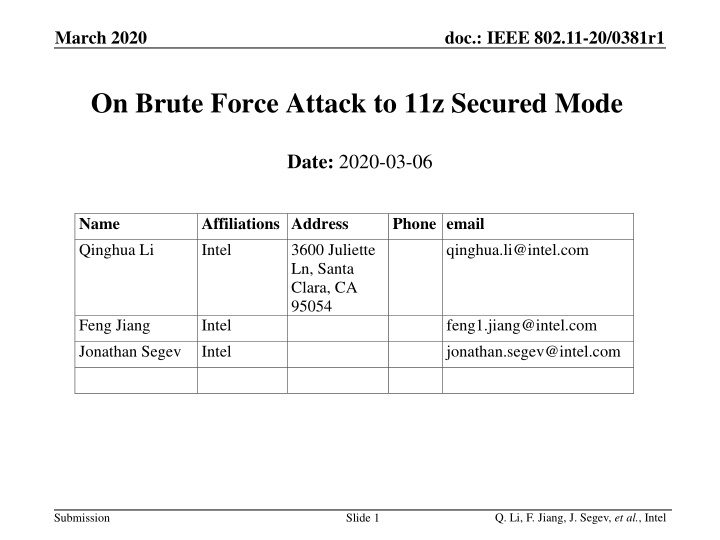
Protecting IEEE 802.11-20 Networks Against Brute Force Attacks
Addressing concerns about the security of IEEE 802.11-20 networks, particularly against time-domain brute force attacks at the sub-symbol level. The submission by Qinghua Li, Feng Jiang, Jonathan Segev, and others from Intel discusses the implementation of specific solutions to enhance the secured mode and protect against potential attacks.
Download Presentation

Please find below an Image/Link to download the presentation.
The content on the website is provided AS IS for your information and personal use only. It may not be sold, licensed, or shared on other websites without obtaining consent from the author. If you encounter any issues during the download, it is possible that the publisher has removed the file from their server.
You are allowed to download the files provided on this website for personal or commercial use, subject to the condition that they are used lawfully. All files are the property of their respective owners.
The content on the website is provided AS IS for your information and personal use only. It may not be sold, licensed, or shared on other websites without obtaining consent from the author.
E N D
Presentation Transcript
March 2020 doc.: IEEE 802.11-20/0381r1 On Brute Force Attack to 11z Secured Mode Date: 2020-03-06 Name Qinghua Li Affiliations Address Intel Phone email 3600 Juliette Ln, Santa Clara, CA 95054 qinghua.li@intel.com Feng Jiang Jonathan Segev Intel Intel feng1.jiang@intel.com jonathan.segev@intel.com Q. Li, F. Jiang, J. Segev, et al., Intel Submission Slide 1
March 2020 doc.: IEEE 802.11-20/0381r1 Background A concern was raised as to the strength of the secured mode against time-domain brute force (computational intensive) attack at the sub-symbol level This submission addresses the concern related to CID 3911 Q. Li, F. Jiang, J. Segev, et al., Intel Submission
March 2020 doc.: IEEE 802.11-20/0381r1 Content Recap of 11az secured mode Recap of the brute force attack Requirements of the attack Implementation specific solutions Q. Li, F. Jiang, J. Segev, et al., Intel Submission
March 2020 doc.: IEEE 802.11-20/0381r1 PHY Level Protection (1/2) Protection is achieved by sounding signal randomization and consistency check Large sets of randomized sounding signals are generated e.g. 2 109 and 8 1012 for 20 and 160 MHz channels, respectively Randomized sounding symbols vary from symbol to symbol The randomization is on both frequency and time domains i.e. 8PSK modulation and random CSD Legacy portion HE portion 8 s per Secure HE-LTF with zero-power GI 8 s 8 s 4 s 4 s 8 s 8 s 4 s Secure HE-LTF 1 Secure HE-LTF n L-SFT L-LTF L-SIG RL-SIG HE-SIG-A HE-STF ... PE 1.6 s zero-power GI Q. Li, F. Jiang, J. Segev, et al., Intel Submission
March 2020 doc.: IEEE 802.11-20/0381r1 PHY Level Protection (2/2) Receiver checks whether the channels estimated from multiple sets of sounding symbols are the same If the attack signal is not the genuine sounding signal, it generates fake channel arrivals widely spread in the time domain. Furthermore, the fake channel arrivals vary from sounding to sounding because the attack signal can t follow the sounding signal variation consistently True 1st tap Spoofed 1st tap With Legacy LTF symbols Noise level Concentrated, high power spoofed taps True 1st tap With random sounding symbols Noise level Suppressed, low power spoofed taps Q. Li, F. Jiang, J. Segev, et al., Intel Submission
March 2020 doc.: IEEE 802.11-20/0381r1 Brute Force Attack Attacker detects which sounding signal is being sent by analyzing the beginning portion of the signal Once detected, attacker sends the remaining portion of the sounding signal ahead of the genuine transmitter Billions or trillions of correlators S(1) t(1) Find the matched signal and send the latter portion with a time shift t(k) S(k) S(k) t(k) S(2x109) t(2x109) Q. Li, F. Jiang, J. Segev, et al., Intel Submission
March 2020 doc.: IEEE 802.11-20/0381r1 Remarks Listen before attack The transmitted attack signal is always partial i.e. missing the beginning portion Inherent problem for OFDM There are other ways to attack OFDM sounding signal Q. Li, F. Jiang, J. Segev, et al., Intel Submission
March 2020 doc.: IEEE 802.11-20/0381r1 Requirements of the Attack Detection rate needs to be high e.g. 50%. Otherwise, consistency check catch the attack e.g. after 8 repetitions Received signal needs to be interference-free and distortion-free. Otherwise, detection rate gets affected Result in visible horn antennas High complexities e.g. billions or trillions of correlators are needed to meet the stringent delay requirement Check 2 109 ~ 8 1012 sequences within few microseconds e.g. 4 10-6 seconds For example, 1.6 1016 ~ 6.4 1020 multiplications per second Q. Li, F. Jiang, J. Segev, et al., Intel Submission
March 2020 doc.: IEEE 802.11-20/0381r1 Requirements of the Attack (2/2) Synchronize to the attenuated, received signal Handle the unknown windowing function Windowing function unknown to the attacker Align the attenuated and tampered signal with the stored sequences Time Q. Li, F. Jiang, J. Segev, et al., Intel Submission
March 2020 doc.: IEEE 802.11-20/0381r1 Fending off the Attacker There are simple ways against the attack without changing 802.11az spec The Transmitter can introduce interferences, distortions, and fake sounding signal to the beginning portion of the sounding signal The Receiver can identify the partial sounding signal transmitted by the attacker and trigger an alert Q. Li, F. Jiang, J. Segev, et al., Intel Submission
doc.: IEEE 802.11-20/0381r1 March 2020 Example 1: ISI Introduced by Transmitter (1/3) Example of adding one delayed signal [1] HE- STF 1 ?2 Signal 1 Signal 2 Signal 3 Signal 4 TX antenna 1 Signal 2 Signal 1 Signal 3 Signal 4 HE- STF TX power splitting and random phase rotation Signals shifted by linear delay Q. Li, F. Jiang, J. Segev, et al., Intel Submission
doc.: IEEE 802.11-20/0381r1 March 2020 ISI Introduced by Transmitter (2/3) No effect to time of arrival measurement ToA Estimated multipaths Delay Multipaths for TX signal delayed 1 ?2 Multipaths for TX signal not delayed Since the delayed transmission only introduces multipaths after the first channel arrival, it doesn t affect the time of arrival (ToA) estimation Q. Li, F. Jiang, J. Segev, et al., Intel Submission
doc.: IEEE 802.11-20/0381r1 ISI Introduced by Transmitter (3/3) The introduced ISI makes the received signal does not match with any of the signals stored in the correlators The attacker needs to jointly estimate the sounding signal and the introduced phases, magnitudes, and delays for removing the ISI with a multiplied complexity The attacker can not use the legacy LTF to estimate the introduced phases, magnitudes, and delays for removing the ISI because the delayed transmissions are not applied to the legacy LTF Legacy portion HE portion 8 s per Secure HE-LTF with zero-power GI 8 s 8 s 4 s 4 s 8 s 8 s 4 s Secure HE-LTF 1 Secure HE-LTF n L-SFT L-LTF L-SIG RL-SIG HE-SIG-A HE-STF ... PE 1.6 s zero-power GI Q. Li, F. Jiang, J. Segev, et al., Intel Submission
doc.: IEEE 802.11-20/0381r1 March 2020 Example 2: Fake Sounding Introduced by Transmitter A fake sounding signal different from the intended one is sent ahead of the intended one such that the attacker locks onto the fake for the sequence search Preceding, covering sounding signal that the attacker locks on Intended sounding signal Time Zero power CP Q. Li, F. Jiang, J. Segev, et al., Intel Submission
doc.: IEEE 802.11-20/0381r1 Detecting List-before-Attack Type of Attacks The attack signal generating the fake first channel arrival is always incomplete i.e. missing the beginning portion Receiver can detect the incompleteness of the signal corresponding to the first channel arrival and trigger an alert [2] Genuine signal s(k) t(k) t(k) Attack signal Q. Li, F. Jiang, J. Segev, et al., Intel Submission
doc.: IEEE 802.11-20/0381r1 Recap of Attack Detection (1/2) Receiver estimates the channel assuming sounding signals are complete Estimated channel arrivals below noise/interference level are removed Genuine signal s(k) t(k) t(k) Attack signal t(k) Received superimposed signal t(k) s(k) Fake 1st arrival Genuine 1st arrival Estimated channel Noise/interference level Q. Li, F. Jiang, J. Segev, et al., Intel Submission
doc.: IEEE 802.11-20/0381r1 Recap of Attack Detection (2/2) Received signal is reconstructed using the estimated channel arrivals above threshold The reconstructed signal is subtracted from the received signal Large residual triggers an alert t(k) Received superimposed signal t(k) S(k) Fake 1st arrival Genuine 1st arrival Estimated channel above threshold S(k) t(k) Reconstructed received signal t(k) S(k) Large residual Residual signal after subtraction Noise/interference level Q. Li, F. Jiang, J. Segev, et al., Intel Submission
March 2020 doc.: IEEE 802.11-20/0381r1 Conclusion The feasibility of the attack is questionable Use of horn antennas Access to Wi-Fi PHY Ability to make architecture HW changes to incorporate a huge amount of correlators and feed into transmission Cost of HW development (how many GFLOPs ?) There are low cost ways to deal with the attack Transmitter sends covering signal protecting the beginning portion of the sounding signal Receiver identifies the presence of partial attack signal Solutions are proprietary without any spec change Q. Li, F. Jiang, J. Segev, et al., Intel Submission
March 2020 doc.: IEEE 802.11-20/0381r1 Reference [1] Qinghua Li, Feng Jiang, Jonathan Segev, et al., On Unintentional Beamforming, IEEE 802.11-19/2032r4 [2] Feng Jiang, Qinghua Li, Jonathan Segev, et al., Replay Attack Detection Using LTF with Zero Prefix, IEEE 802.11-18/0208r0 [3] Apple Inc., Computational Attacks on 11az PHY Secure Ranging. Q. Li, F. Jiang, J. Segev, et al., Intel Submission
March 2020 doc.: IEEE 802.11-20/0381r1 Backup Q. Li, F. Jiang, J. Segev, et al., Intel Submission
March 2020 doc.: IEEE 802.11-20/0381r1 Other considerations (even without considering 11az changes) The requirement on the attacker are quite high: Attack cost: non-recurring cost Attacker has to have access to 802.11ax PHY. Attacker has to be able to make HW architecture and FW changes to 802.11ax PHY to support: Insertion of sampler at the correct timing reading of the Ranging NDP frame Legacy and HE portions. HW and memory to compute of correlators of brute force (including 109 sequences storing for 20MHz, >1012 for 160MHZ). Injection of synthesized symbol with highest correlation back into Tx path with Timing Advance control mechanism Attack cost: recurring Attacker relies on LOS assuming AWGS flat channel. Most likely would have to use horn antennas (physically large and expensive) Q. Li, F. Jiang, J. Segev, et al., Intel Submission
March 2020 doc.: IEEE 802.11-20/0381r1 Other considerations Reduced set brute force correlator (reduced computation): In [3] the author proposes to simplify the computation by trying only 1/100 reducing computation to 1% at the expense of success rate reduced to 1%. This approach is fallacy from attacker side: 11az support multi LTF symbol per frame each LTF symbol sequence is independent, Reduced brute force attack can easily be fended off using 11az Repetition. Repetition = 2 will yield 1/104 probability, repetition of 3 will yield 1/106 ,repetition 4 will yield 1/108 effectively making the attack negligible at almost no medium cost (8usec per repetition to maximum of 64). Q. Li, F. Jiang, J. Segev, et al., Intel Submission

